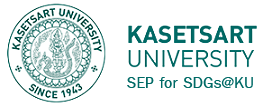
At present, the world is changing rapidly and affecting water resources in many ways. Kasetsart University therefore issues a policy to response to the national strategy on water management in a variety of activities and measures under various projects. For example, 5 Sor activities, green office activities, installation of publicity banners and post on the web pages of sub‐ agencies, including big annual events, such as Agricultural Fair on the theme of work against drought campaign, sports events, etc. In accordance with the educational policy that requires students and the public to participate in activities together, Kasetsart University has organized a study visit and observation activity with public and private agencies, such as the Provincial Waterworks Authority, the Irrigation Department, etc. to increase the opportunity to exchange and learn about effective water management. Meanwhile, to handle drought conditions, there is a policy that focuses on the existing water reservoirs in various areas for maximizing the usage, both in terms of water quality treatment for consumption and use of treated water for maximum benefit. Also, there is the expansion of the area to study the water sources surrounding communities, along with sharing innovation and knowledge of experts in Kasetsart University to develop agencies within KU and in nearby rural areas efficiently and effectively, which can expand the results to develop the degraded areas in order to achieve sustainable allocation of water resources in accordance with the objectives of the sufficiency economy principle of King Rama 9.
4.2 Water Recycling Program Implementation.



4.2 Implementation of Water Recycling Program
4.2-1 The university applies the sufficiency economy philosophy on water management to increase the efficiency of agricultural utilization. The objective is to promote and introduce the royal speech of King Bhumibol Adulyadej on the new theory of agriculture based on the sufficiency economy concept to manage water and agricultural areas combined with local wisdom by dividing the area into the proportion of 30: 30: 30: 10 for the maximum benefit.
The university applies a policy for water management and water conservation within all campuses of Kasetsart University to ensure the water resource sustainability and water usage efficiency. The university therefore prepares a pond for water treatment. Also, the water in the treatment pond is used for further benefit. There are natural methods of water treatment by growing aquatic plants to absorb odors and reduce substances contaminated in the wastewater, using a water dispenser and water pump with sprinkler system to increase oxygen and improve water conditions together with sunlight exposure. A solar water pump and water-hitting turbine are used to circulate the water in the canal by using solar energy in the form of heat to recycle the water. The water in the treatment pond is used in various ways, for example, watering plants and lawns, cleaning truck and garbage collecting vehicles.
Public service – Kasetsart University offers an opportunity for students and organizations to study and visit the wastewater treatment system for further application.
Agricultural innovation – The university has applied water circulation innovation for growing hydroponic crops to reduce water loss. This method of growing vegetables uses a very small amount of water compared to the regular irrigation method. In addition, there is also a wastewater treatment innovation using solar powered water pumps to reduce the consumption of electric energy as well.
4.2-2 From the water management and water conservation policy, the university has established guidelines for water saving and conservation by applying a water circulation system in hydroponic vegetable cultivation and tilapia fry hatching, using the water recycling process in dairy center, drinking water production for Kasetsart University, cleaning the building floors and toilet flushing system, and using water from natural pond with a water drip system to grow vegetables for water loss reduction, tap water replacement and worthwhile water usage.
Kasetsart University, Kamphaeng Saen Campus, has co-operated on the installation of underground raw water pipeline at Kamphaeng Saen Campus with the Royal Irrigation Department to water storage and better water management, which is now in the process of laying raw water pipelines and ditches. Building new ditches and laying water pipelines are a water delivery system for production of tap water and drinking water inside Kamphaeng Saen Campus effectively without exposing to contaminants. Meanwhile, the original ditches will be used for agriculture and various agricultural research plots of Kamphaeng Saen Campus.


Water recycling by growing hydroponic crops with water recirculation system. The water will be pumped from the expansion tank to flow along the trough. The water will circulate for 24 hours a day, so fertilizers can be added at the same time, which saves more water than traditional fertilizing method.
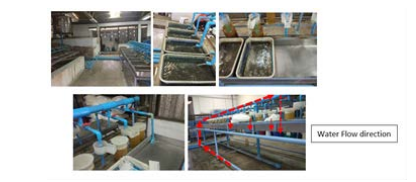
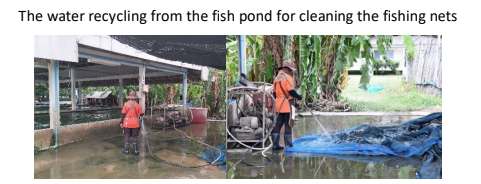
For water recycling system in tilapia hatchery, the water used for hatching tilapia fry will be controlled for a constant flow. The water from the incubator will flow down to the water tray before flowing into the PVC pipe and circulate through the tube to flow back to the top of the incubator. This type of circulating system makes it possible to reduce the amount of water needed per day. The amount of new water to be added each day is approximately 2% of the total system water volume, which is approximately 20 liters.
Public service – Kasetsart University has provided classes on hydroponic vegetable cultivation and tilapia fry hatchery by using the water circulation system to students and people nearby to increase knowledge and skills. It also provides opportunities for organizations and various departments to participate in the trainings as well.
Agricultural innovation – The university emphasizes the effective use of resources through development and innovation of water circulation systems for hydroponic vegetable cultivation, tilapia fry hatchery and water recycling process used in dairy center, university’s drinking water production, building floor cleaning, bottles and gallons cleaning, together with recycling water used in toilet system in the university and using the treated water for car wash as well.
Socials engagement – Growing vegetables in greenhouses is part of the center of agricultural technology under the cooperation between Kasetsart University, Nakhon Pathom Province, and a group of leading Israeli agricultural technology companies, which has been supported from the Israeli government.
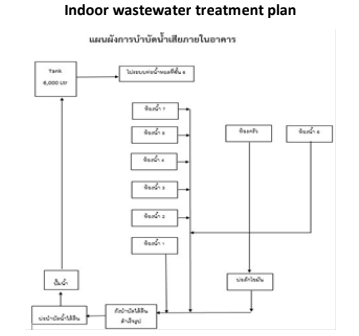


4.2-3 Kasetsart University has a proper and efficient wastewater treatment, an established water treatment plan, quality inspection, a wastewater management system to prevent the release of untreated wastewater from buildings to public areas, including a waste water recycling system with a pump connected upwards for use in toilets, kitchens and plant watering on various floors in the building.
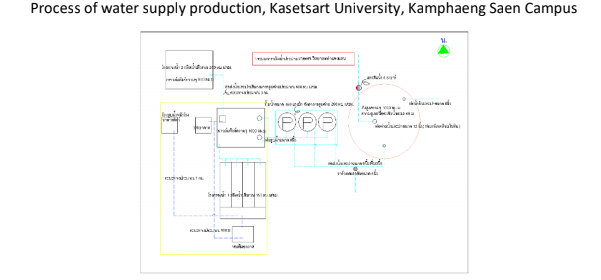
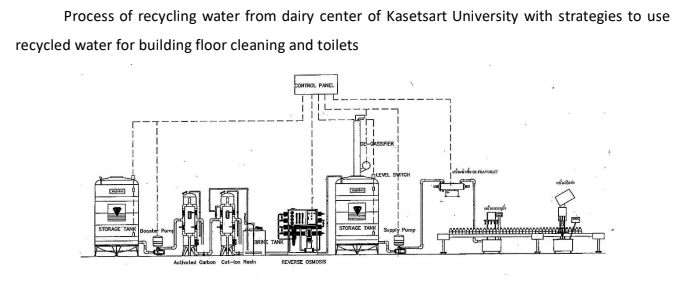

Kamphaeng Saen Campus receives water directly from Srinakarin Dam, Kanchanaburi, through the irrigation canal into the reservoir (pond 1), which is the most important main pond on an area of 130 rai. The campus has prepared 7 large ground-digging ponds for internal water use and shared with the communities around the campus. Also, more canals has been dig around the campus for water support, agricultural research and experiment, animal farms, including plant watering, instead of using tap water. Water production system of Kamphaeng Saen Campus is a “fast sand filler system”. There are 2 sources of raw water used to produce tap water, including 1. groundwater 2. surface water.
Challenge – Reduce water consumption and university expenses, increase water recycling programs, for example, organizing a conservation building contest, reduce the cost of water recycling water in accordance with the university’s water management policy to achieve the water resource sustainability and water usage efficiency. In the future, the university will adopt new water treatment innovations, build a network of local community, and exchange knowledge on water management and community wastewater treatment.
Opportunities – Kasetsart University applies the government policies for manage and conserve water efficiently, especially in Nakhon Pathom, Sakon Nakhon and agricultural areas. The university realizes social policies, and therefore implements various projects for sustainability by adopting agricultural technology system to encourage students, staff and nearby communities to have knowledge and understanding about water conservation, efficient water usage and to increase the amount of water recycling with every campus and nearby communities.

The prc covid-19 period
According to the hygiene surveillance measures and the outbreak of COVID-2019, Kasetsart University has a water management policy before the COVID incident. All departments were encouraged to reuse the treated water to clean the building of the school center by using disinfectant alcohol to wipe clean service areas and touch points, common areas, classrooms, including toilets, elevators, doorknobs and building stairs, including audiovisual equipment for teachers, and assigning the building staff to clean regularly for good hygiene for students, teachers and personnel.
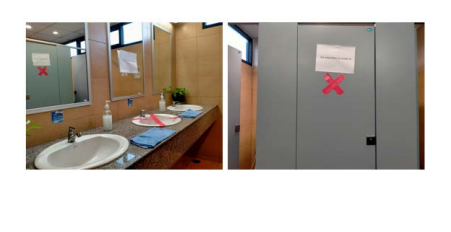
The between covid-19 period
The university has a policy of using recycled water for cleaning up areas to save water resources and reduce COVID-19 outbreaks by distancing while using sinks and toilets for sustainable management.
Remark : All activities in 4.2 refer to the Sustainable Development Goals (SDGs), otherwise known as the global goals, especially relating to Goal 6 : Clean Water and Sanitation which Improve water quality by reducing pollution, eliminating dumping and minimizing release of hazardous chemicals and materials, halving the proportion of untreated wastewater and substantially increasing recycling and safe reuse globally Another significant target of this goal is to Protect and restore water-related ecosystems, including mountains, forests, wetlands, rivers, aquifers and lakes.
